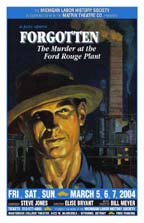 |
Forgotten: The Murder at the Ford Rouge Plant A Jazz Opera The Story |
|||
|
Summary Who was Rev. Bradford? "The Forgotten Man's Hour" Father Charles Coughlin The Ford Hunger March The River Rouge Plant African Americans and the Success of the CIO Lewis Bradford Harry Bennett The Battle of the Overpass Layoffs and Intimidation Muriel Lester Lewis is Attacked Lewis Dies Locating the Autopsy A City Mourns Who Knew? UAW Wins at Ford Acknowledgments Bibliography |
We had known about Lewis Bradford's murder for years. He was married to Ella Bradford, my grandfather's cousin. Like my grandfather, Lewis was a Methodist minister strongly influenced by Muriel Lester, a British socialist and pacifist and founder of the Fellowship of Reconciliation. Lewis worked the Ford Motor Company assembly line for 18 months in 1936-37. Newspaper accounts say he had a "vision of labor peace", in a time of bitter labor struggles. Henry Ford, and his chief "enforcer", Harry Bennett, ruled with an iron fist over the River Rouge plant, largest factory in the world. According to veteran organizer Victor Reuther, "To a larger extent than any other major corporation in the country, Ford engaged in open and shameless acts of terrorism, to prevent its workers from joining a trade union" (p. 197, The Brothers Reuther, by Victor Reuther, 1976). Lewis's widow, Ella, recalled how he formed a group, "The League of One Thousand Men", that met Sunday afternoons away from the plant. "The meetings had become popular... The attitude of fear was beginning to break down... Lewis Bradford was threatening Bennett's rule of terror and his whole plan." (p. 5, letter from Ella Bradford to daughter Helen, March, 1965). Lewis Bradford died on November 30, 1937, as a result of a fractured skull, which occurred inside the Rouge plant. The Ford Motor Company claimed it was an accidental fall. The family was told to leave town and don't ask questions. The obituary writer was picked up by Bennett's thugs not once, but twice and brought before Harry Bennett. There were two revolvers on his desk, as Bennett instructed the writer how to craft the wording in the newspaper.
My journey these past two years has been to find out more about this story. As a musician, I've written a musical based on Lewis's life and death. In the process, I've observed, in a very personal way, labor history in this pivotal time of 1930's Detroit, through the eyes of this former minister who died while helping to build the union. |
|||
The "Forgotten" Story * Performances * News * Orders About Us * Contact Us * Home |